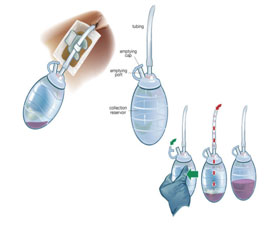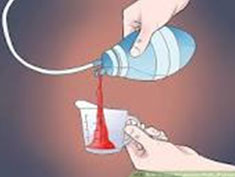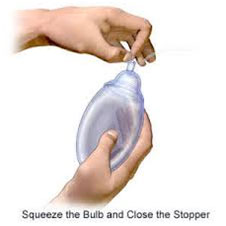Jp drain care
What is the purpose of a drain?
During a mastectomy the breast is separated from subcutaneous tissue and muscle. This results in a raw surface that leaks fluid called serous fluid. Although serous fluid production is normal, we don’t want the fluid to stay inside, we want it to come out, so a drain is placed. There are different types of drains. Dr. Miltenburg uses a Jackson-Pratt or JP drain. As the tissues grow together the fluid production slows down and eventually stops. This process takes about 14 days. Once drain production is less than 1 ounce (30 ml or 30 cc) in 24 hours, the drain can be removed.

What are the 2 most important things to know about wound drainage / drains?
- Postoperative serous fluid must come out and not accumulate inside the body.
- Bacteria must not enter the drainage system or the fluid will become infected.
Follow these instructions carefully to keep drains working properly and prevent infection.
You will need:
- Small measuring cup provided by the hospital
- JP DRAIN RECORD (provided on this web site)
- Cotton tipped applicators / Q-tips
- Normal saline
- Triple antibiotic ointment or Polysporin
- 4 x 4 inch dressing gauze, unsterile or sterile
- Medical tape
How to empty and record the wound drainage / JP drainage
- Empty the JP drain every 12 hours beginning on the evening you get home from the hospital.
- Use the small measuring cup you received from the hospital and the daily record sheet included on the website.
- Wash your hands thoroughly with soap and water.
- Start by stripping the drain tube so any clots that could clog the system are pushed out. To do this, grasp the tubing near the patient’s body, firmly squeeze the tubing and work downward toward the drain bulb, taking care not to let pressure off the tube. Do this as many times as necessary to work out any clots or solid material. The person who is working the tubing may feel some burning on their fingers due to friction but stripping should not should not hurt the patient. If there aren’t any clots or solid material you will only have to do this once or twice but be sure to do it every time you empty the bulb. Sometimes stripping will cause the tubing to collapse but don’t worry about that, the tubing will open up again on its own.

- Remove the cap from the bulb and gently squeeze the fluid out of the bulb into the measuring cup that you brought home from the hospital.

- Put the measuring cup on a flat surface and measure the fluid in milliliters (ml) (Note: 1 ml = 1 cc and 30 ml or 30 cc = 1 ounce). You can use ounces if you’re more comfortable with that.
- Throw the fluid away. Rinse the measuring cup and put it away for the next time. Do not rinse any part of the JP drain or take the drainage system apart.
- Squeeze the JP bulb so the sides touch on the inside and close the cap/stopper.

IF THE BULB IS NOT SQUEEZED OR IF THE BULB IS FILLED WITH FLUID IT WILL NOT DRAW THE FLUID OUT.
- Repeat the stripping and emptying routine at the same time every morning and evening (twice a day) and whenever the bulb is half to two thirds full. You can do it more often if necessary but be sure to record the amount of drainage every time. If you have more than one drain keep a separate total for each one.
- The drainage will be bright red at first then pinkish then clear yellow.
- Bring the JP DRAIN RECORD to the surgeon’s office for every visit.
How to care for the JP drain site Caring for the surgical wound / incision
- You may take a shower and begin JP drain site care 48 hours after surgery.
- Place a ribbon, cloth belt or similar item around your waist to secure the drain while taking a shower.
- Be sure that the person taking care of the drain washes their hands thoroughly with soap and water.
- Remove the drain dressing after the shower.
- Strip and empty the drain as described above in steps 4 – 8.
- Pour normal saline on a clean Q-tip and cleanse around the drain. Wipe up the excess saline with gauze.
- Using another Q-tip put the antibiotic ointment or Polysporin around the drain site.
- Place clean gauze over the drain site and tape it in place with medical tape.
- Use a safety pin to secure the bulb to your underwear.
- Do this once a day, after you shower.
10 reasons to call the Doctor’s Office about wound healing / JP drain
- The bulb does not hold suction
- The drainage suddenly stops or turns bright red
- The tubing falls out or a lot of fluid leaks out around the tube
- There is sudden, severe pain and swelling that looks like the breast is growning back
- You notice signs of infection such as severe pain, swelling, warmth or redness larger than silver dollar
- The fluid in the bulb becomes cloudy, murky or has a foul smell
- Fever or temperature greater than 100.4 degrees
- Postoperative pain is getting worse
- The incision opens up or begins to drain fluid that soaks through the dressing
- If it has been at least 10 days since surgery and the drainage is less than 30 ml in 24 hours for 2 days in a row, it is probably time to remove the drain.

10 things not to do while recovering from major breast surgery
(A.K.A. Surgical Wound Healing)
- You can start taking a shower 48 hours (2 days) after surgery but do not take a shower without help. Place a stool in the shower or just outside it in case you feel faint.
- Do not soak in a bathtub, pool, hot tub, lake or ocean.
- Do not smoke, drink alcohol, or take any illegal drugs.
- Do not let your pain become greater than 6 on a 0-10 scale. Take your pain medication if the pain is 4 or higher.
- Do not drive until the JP drains have been removed.
- Do not lift, carry, push, pull or move anything that weighs more than 10 pounds or bend over to reach your knees, feet or the floor.
- Do not “baby” your arm too much or it will freeze up. It is O.K. to brush your hair, brush your teeth and make a sandwich or a cup of tea. After the first week most patients should be able to move their arm around normally.
- Do not overexert yourself. Rest is very important. You have a limited amount of energy and all of it should be focused on healing and recovery. Minimize visits to 1 hour. Tell your loved ones to pray for you instead or make a casserole.
- Do not go to work, shopping, sporting events or social events.
- Do not lie or sleep on your incision or JP drain, if possible.
